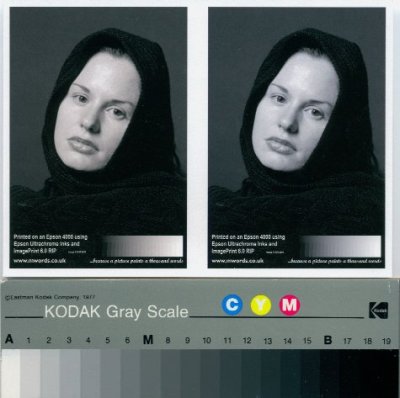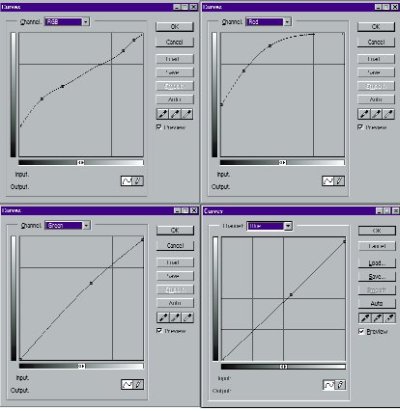articles/Monochrome/monomagic-page4
Monochrome Magic - part 4 of 1 2 3 4 5 6 7 8
Published 01/10/2004

A scan of the Imageprint RIP output onto Hahnemuhle Photo Rag using Epson Ultrachrome inks. A warm variant is on the left and a cool neutral variant on the right. It is noteworthy that there is no scanner metamerism as well as no observer metamerism - the inkjet prints have scanned to the same tones as they were measured on the spectro and maintained their relationship to the non-metameric Kodak calibration scale. This is quite a severe test for other inkjet prints!
Image Output
There are a number of choices for output into monochrome. The choice can depend upon the intentions for the final image. If for example the image has to sit in a wedding album which is conventionally printed then it might be better to have your lab process the mono as well to maintain the texture and surface properties.
When it comes to inkjet output there are yet further options to choose from, depending on how the ink set is formulated. Most colour printers use a basic colour set of cyan, magenta and yellow. Depending on the technology, black, grey, light cyan, light magenta, orange, green, red or blue may also be added, although never all of them (at present, currently the limit is 8 colour). These additional inks are used to increase the size of the gamut (not a benefit to a monochrome print) and to smooth the transitions down the tonal range. The down side is that the mixture of colours is adjusted along the tone scale, progressively replacing cyan, magenta and yellow with greys and black - the so called grey replacement. Whilst this is OK for a well-profiled printer, it can lead to variations in the tone colour of the neutrals as the depth of the grey changes. Sadly the eye is also most sensitive to changes of this type. Metamerism can also rear its head (see later). In order to alleviate some of these problems the specialist suppliers such as Permajet, Lyson, Mwords, MIS, Cone and Marrut provide a range of solutions which use all black/grey or near-neutral inks for dedicated monochrome printing and lightly toned printing. Some of these need RGB images, some can utilise both colour and greyscale images. All produce superior monochrome results to unprofiled desktop colour printers with an added benefit of greater light fastness to boot. The Epson Ultrachrome ink set with its light grey and a choice of two blacks is capable of creating monochromes which rival the best of the specialist mono ink sets and the utility Epson Gray Balancer software may be used to apply light toning effects or final tweaks to the neutrality.
Imageprint 5.6
This is a specialist RIP imported by Mwords. Whilst it is not the least expensive solution for creating monochrome it is certainly very effective. As well as a fully featured RIP for colour, profiles are provided for accurate, reduced metamerism monochrome output. This is achieved with Epson Ultrachrome inks by reducing the content of the yellow to the grey mix. Yellow is the bad actor as far as metamerism is concerned. It drops the metameric index to a miniscule 0.6 delta E when changing from D65 daylight to tungsten light for a 50% grey. This is backed by no detectable shift when you walk about the house with a real print - it really works!

Lith Toning
Ithe search to be different wet monochrome printers have sometimes resorted to using lithographic chemicals to develop the printing paper. This is a real black magic type of process, hugely unpredictable, very time consuming (35min to an hour sometimes!) and great fun if you are not paying for your time. An additional effect you get is peppering of the image structure, a kind of darker tone noise on the image. The actual tone of the image can be adjusted from a delightful delicate pink through to a full soot and whitewash effect so beloved of the former Iron Curtain states. This effect is best achieved digitally by adjusting the curves and applying some noise. It has the advantage of great predictability.
In the example shown below the image was scanned from a 120-format monochrome negative to make an RGB file. This was desiderated but left in RGB and then the curves shown below were applied followed by an application of the Noise filter to taste.
The effect is identical to a lith processed wet print which is what was used to generate the curves but the result is more predictable and certainly much quicker to produce.
Please Note:
There is more than one page for this Article.
You are currently on page 4
- Monochrome Magic page 1
- Monochrome Magic page 2
- Monochrome Magic page 3
- Monochrome Magic page 4
- Monochrome Magic page 5
- Monochrome Magic page 6
- Monochrome Magic page 7
- Monochrome Magic page 8
1st Published 01/10/2004
last update 09/12/2022 14:56:49
More Monochrome Articles
There are 0 days to get ready for The Society of Photographers Convention and Trade Show at The Novotel London West, Hammersmith ...
which starts on Wednesday 14th January 2026





